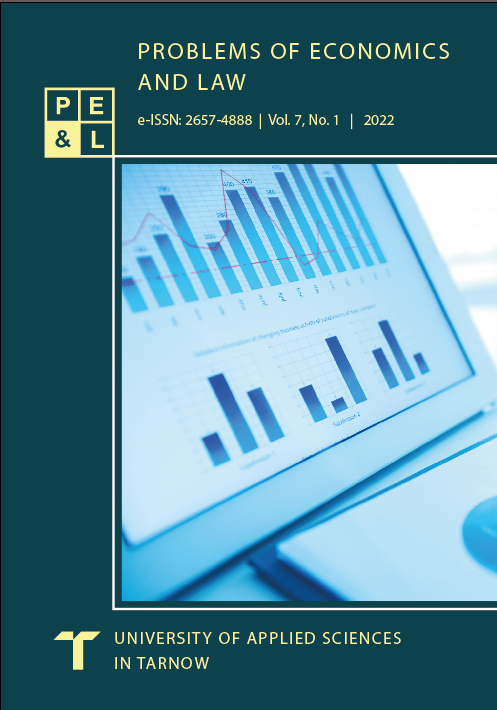The VAT system in the opinion of entrepreneurs and accounting staff
DOI:
https://doi.org/10.55225/pel.430Keywords:
value added tax, VAT, tax system, questionnaire researchAbstract
Purpose of the study: Assessment of the VAT system, with particular emphasis on the changes introduced in 2019–2021.
Materials and methods: The literature on the subject was used to present the theoretical aspects of VAT. The study analyzes and interprets the results of own research conducted among entrepreneurs and people practicing the profession of an accountant. Primary materials were obtained using the diagnostic survey method, the survey technique and the survey questionnaire tool. The study uses a comparative, quantitative and qualitative method. The descriptive, graphical and tabular methods were used to present the results.
Research results: The conducted research proved that the VAT system in Poland requires optimization and simplification. The introduced changes should be consulted and the opinions of experts and entrepreneurs taken into account in the implemented regulations. Both entrepreneurs and accounting staff believe that the applicable VAT regulations are very complicated – which makes running a business difficult. The changes introduced in 2019–2021, according to the majority of respondents, not only did not simplify the procedures used, but introduced more obligations and increased the operating costs of companies.
Downloads
References
Bełdzikowski, M. (2021). Uszczelnianie podatku od towarów i usług z perspektywy podatnika. Kwartalnik Nauk o Przedsiębiorstwie, 61(4), 49–58. DOI: https://doi.org/10.33119/KNoP.2021.61.4.5 Google Scholar
Czubakowska, K., Grodzińska, A. (2013). Ocena systemu podatkowego w opinii przedsiębiorców z województwa zachodniopomorskiego. Zeszyty Naukowe Uniwersytetu Szczecińskiego. Finanse, Rynki Finansowe, Ubezpieczenia, 2(61), 21–33. Google Scholar
Ernst & Young Global Limited. (2018). Split payment oczami przedsiębiorców. Raport z badania. Dostępny w Internecie: https://branden.biz/wp-content/uploads/2018/08/Raport_EY_SPLIT_PAYMENT_2018_08_16_final.pdf [dostęp: 2022-03-31]. Google Scholar
Famulska, T. (2015). Neutralność VAT a finanse przedsiębiorstwa. Zeszyty Naukowe Uniwersytetu Szczecińskiego. Finanse, Rynki Finansowe, Ubezpieczenia, 1(76), 57–65. DOI: https://doi.org/10.18276/frfu.2015.76/1-05 Google Scholar
Kasprzak, P. (2016). Wpływ podatku VAT na działalność gospodarczą: analiza wybranych przykładów. Przedsiębiorczość Międzynarodowa, 2(1), 109–119. Google Scholar
Nakonieczny, J., Nesterowicz, R. (2021). Ocena systemu podatkowego w opinii przedsiębiorców z województwa podkarpackiego. Przedsiębiorczość – Edukacja, 17(2), 9–26. DOI: https://doi.org/10.24917/20833296.172.1 Google Scholar
Pałys, A. (2021). Krajowy System e-Faktur (KSeF) – kontekst prawny, wyzwania techniczne i konsekwencje praktyczne dla przedsiębiorców. Przegląd Podatkowy, 12, 21–26. Google Scholar
Szlęzak-Matusewicz, J. (2012). Przedsiębiorca a system podatkowy w Polsce. W: Ł. Woźny (red.). Ekonomia, finanse i zarządzanie w świetle nowych wyzwań gospodarczych: wyniki badań młodych naukowców Kolegium Zarządzania i Finansów SGH. Warszawa: Oficyna Wydawnicza Szkoły Głównej Handlowej. Google Scholar
Szulc, M. (2022). Krajowy System e-Faktur zaliczył falstart. Dziennik Gazeta Prawna, 17 stycznia [online]. Dostępny w Internecie: https://podatki.gazetaprawna.pl/artykuly/8334336,vat-krajowy-system-e-faktur.html [dostęp: 2022-03-31]. Google Scholar
Zblewska, K. (2019). Luka podatkowa w podatku VAT w Polsce oraz innych krajach unii europejskiej w latach 2014–2018. Przedsiębiorstwo we Współczesnej Gospodarce: teoria i praktyka, 2(29), 13–24. Google Scholar
Downloads
Published
How to Cite
Issue
Section
License
Copyright (c) 2022 Aleksandra Minorczyk, Wojciech Sroka

This work is licensed under a Creative Commons Attribution-ShareAlike 4.0 International License.





